When it comes to manufacturing high-quality drinkware, choosing the right stainless steel grade can make or break your product's success.
Moreover, understanding the differences between various grades helps manufacturers create products that meet both safety standards and customer expectations.
| Property | 316 Stainless Steel | 304 Stainless Steel | 430 Stainless Steel |
|---|---|---|---|
| Composition | 16-18% Chromium, 10-12% Nickel, 2-3% Molybdenum | 18-20% Chromium, 8-10% Nickel | 16-18% Chromium, No Nickel |
| Corrosion Resistance | Excellent (Marine Grade) | Good | Fair |
| Food Safety | FDA & LFGB Approved | FDA Approved | Limited Applications |
| Cost | Premium | Moderate | Budget |
| Magnetic Properties | Non-magnetic | Non-magnetic | Magnetic |
| Best Use | Premium drinkware, marine environments | General drinkware | Basic applications |
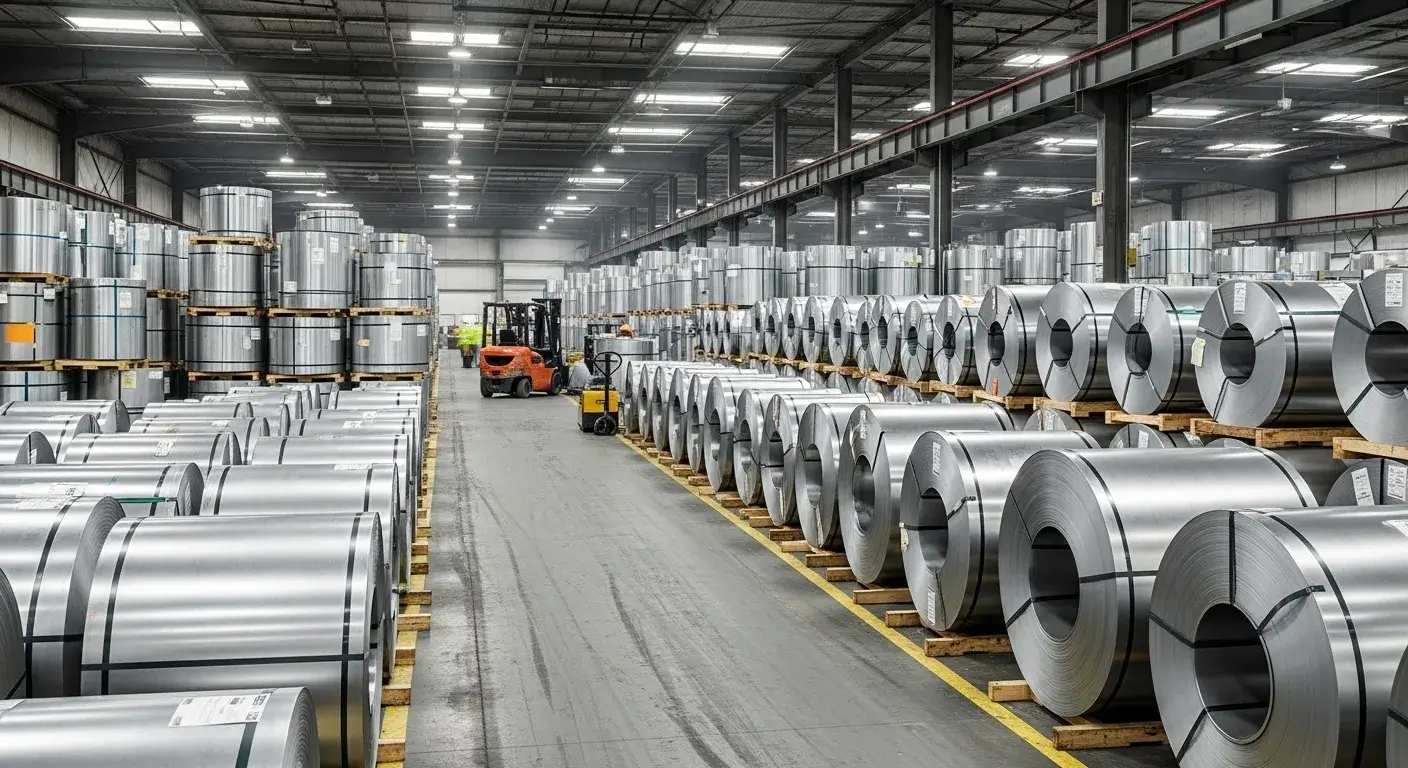
Quick Answer: 316 Stainless Steel Properties at a Glance
316 stainless steel is a premium austenitic grade containing 2-3% molybdenum, which significantly enhances its corrosion resistance. Furthermore, this "marine grade" steel offers superior performance in chloride-rich environments, making it perfect for drinkware applications.
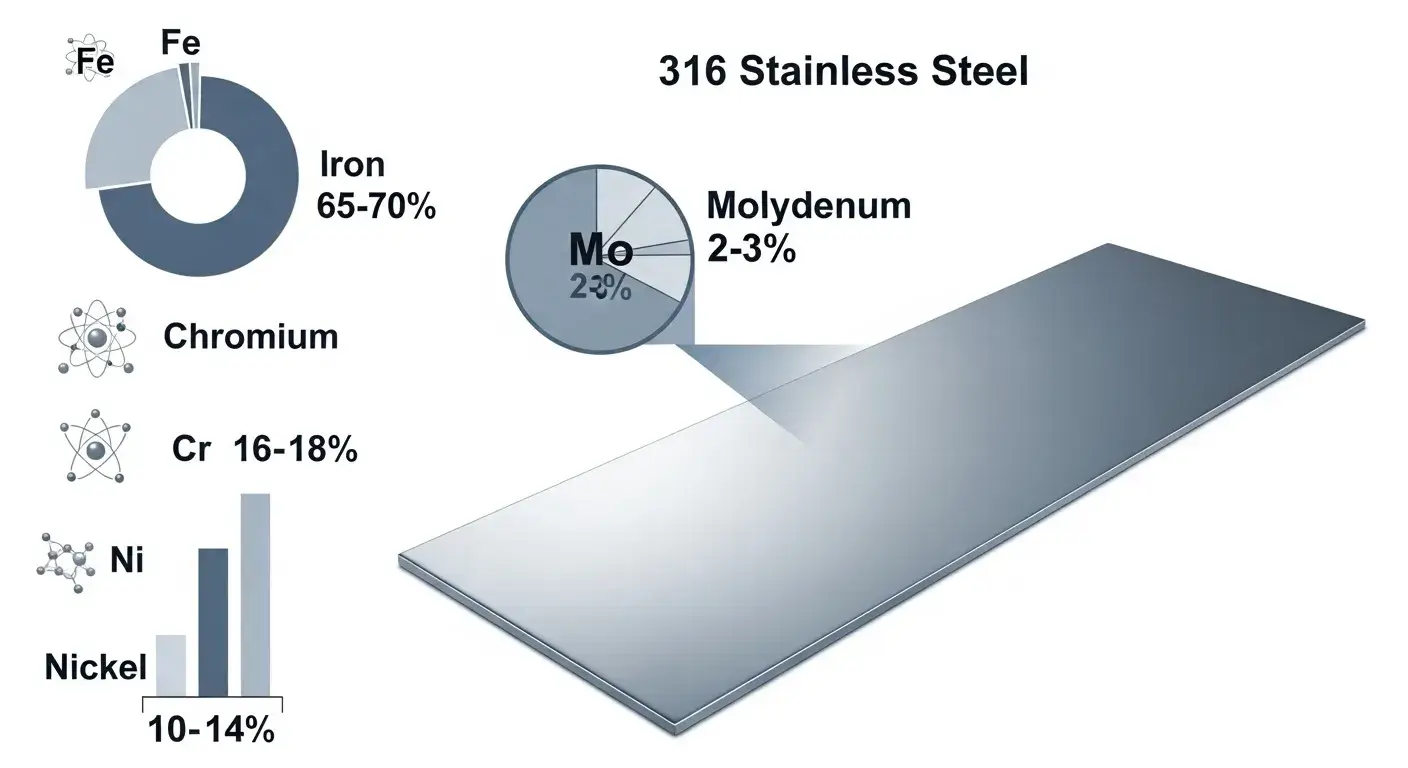
Key Benefits for Drinkware Applications:
- Superior corrosion resistance in acidic beverages and saltwater environments
- FDA and LFGB food safety certifications for direct food contact
- Non-magnetic properties that won't interfere with electronic devices
- Excellent durability with 515-690 MPa tensile strength
- Temperature resistance from -196°C to 870°C
The molybdenum content sets 316 apart from other grades, consequently providing better resistance to pitting and crevice corrosion that can occur with daily beverage use.
Is 316 Stainless Steel Good Quality?
Yes, 316 stainless steel is considered premium quality and represents one of the highest standards in stainless steel manufacturing. Additionally, its quality metrics consistently exceed industry requirements for drinkware applications.
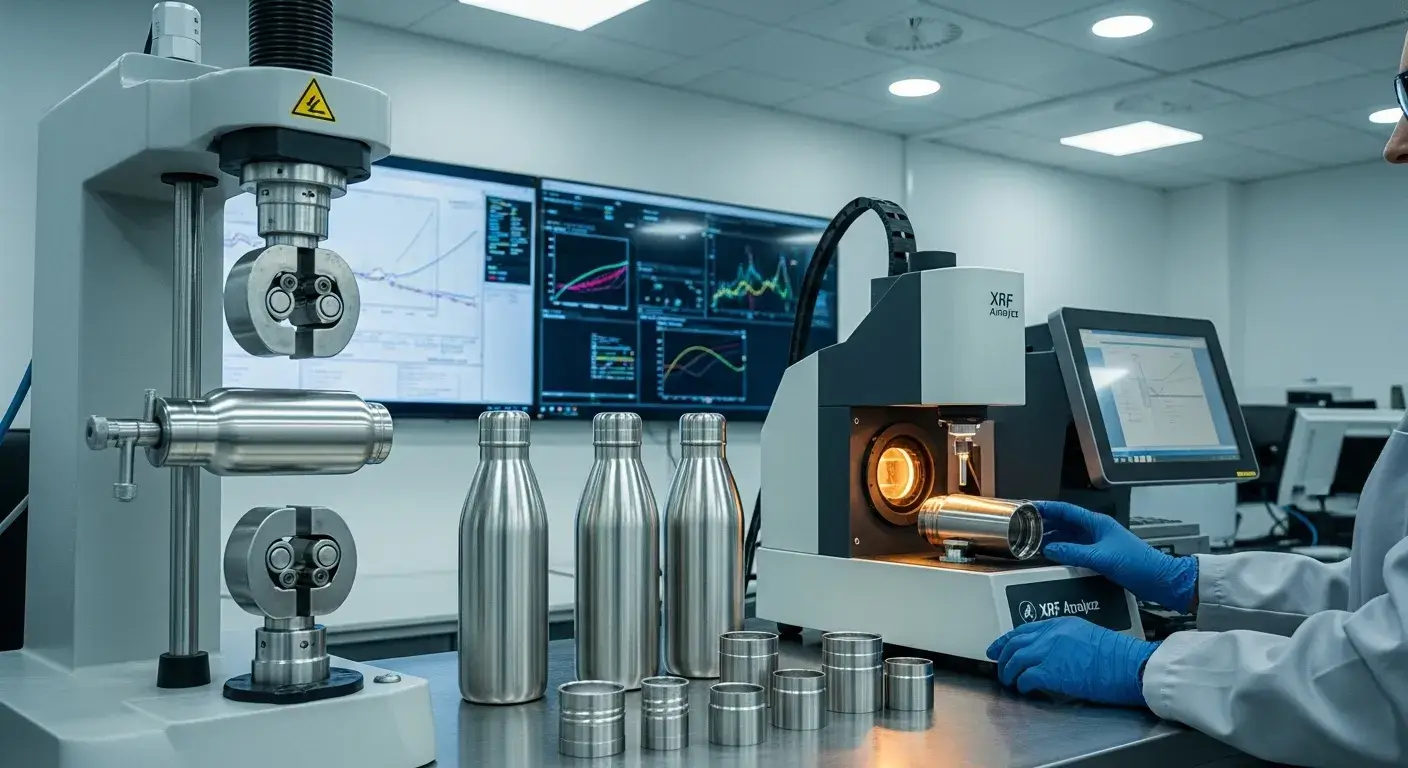
Quality testing laboratory showing 316 stainless steel samples under analysis
Quality Metrics That Matter:
- Tensile Strength: 515-690 MPa (exceeds most competitors)
- Yield Strength: ~290 MPa for excellent structural integrity
- Elongation: ~40% for superior formability during manufacturing
- Corrosion Rate: Less than 0.1mm/year in most environments
Furthermore, 316 stainless steel meets stringent international standards including:
- ASTM A240 (American standard)
- EN 1.4401 (European standard)
- JIS SUS 316 (Japanese standard)
Professional manufacturers consistently choose 316 grade because it delivers predictable performance across diverse applications while maintaining food safety compliance.
316 vs 304 Stainless Steel: Which is Better for Drinkware?
The choice between 316 and 304 stainless steel significantly impacts both product performance and manufacturing costs. However, understanding their differences helps manufacturers make informed sourcing decisions.
Performance Comparison:
| Factor | 316 Advantage | 304 Advantage |
|---|---|---|
| Corrosion Resistance | 40% better in chloride environments | Sufficient for basic applications |
| Cost | 40% more expensive | Budget-friendly option |
| Marine Environments | Excellent performance | May show pitting over time |
| Welding | 316L variant ideal | Good for most applications |
| Food Safety | Premium compliance | Standard compliance |
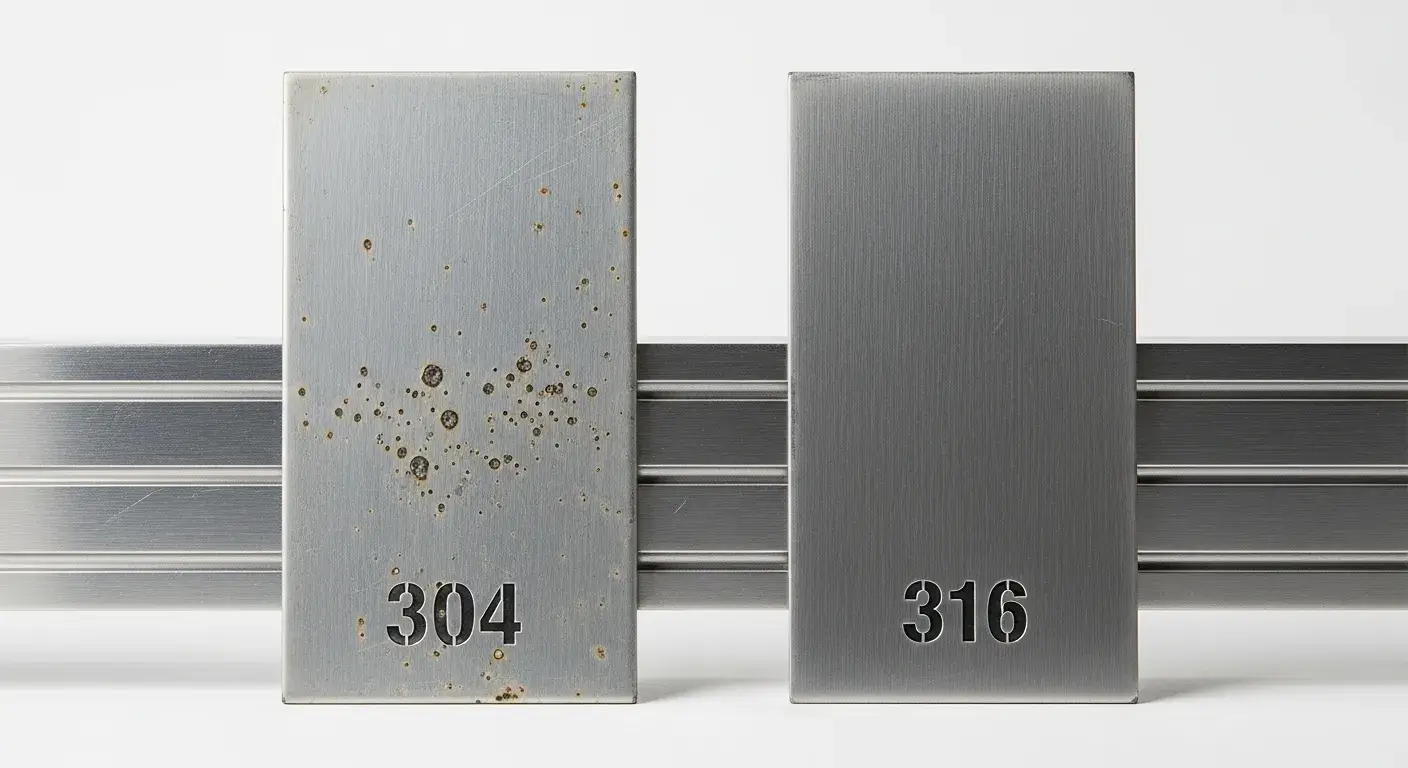
Side-by-side corrosion testing of 316 vs 304 stainless steel samples
When to Choose 316:
- Premium product lines targeting quality-conscious consumers
- Marine or coastal markets where salt exposure is common
- Acidic beverages like citrus juices or sports drinks
- Long-term warranty offerings requiring superior durability
When 304 Might Suffice:
- Budget-conscious markets where cost is the primary factor
- Basic water bottles for everyday use
- High-volume production where margins are tight
According to the International Stainless Steel Forum, 316 grade represents approximately 20% of global stainless steel consumption, reflecting its premium positioning in the market.
Why 316 Stainless Steel is Perfect for Water Bottles and Tumblers
316 stainless steel's unique properties make it exceptionally well-suited for drinkware manufacturing. Consequently, leading brands increasingly specify this grade for their premium product lines.
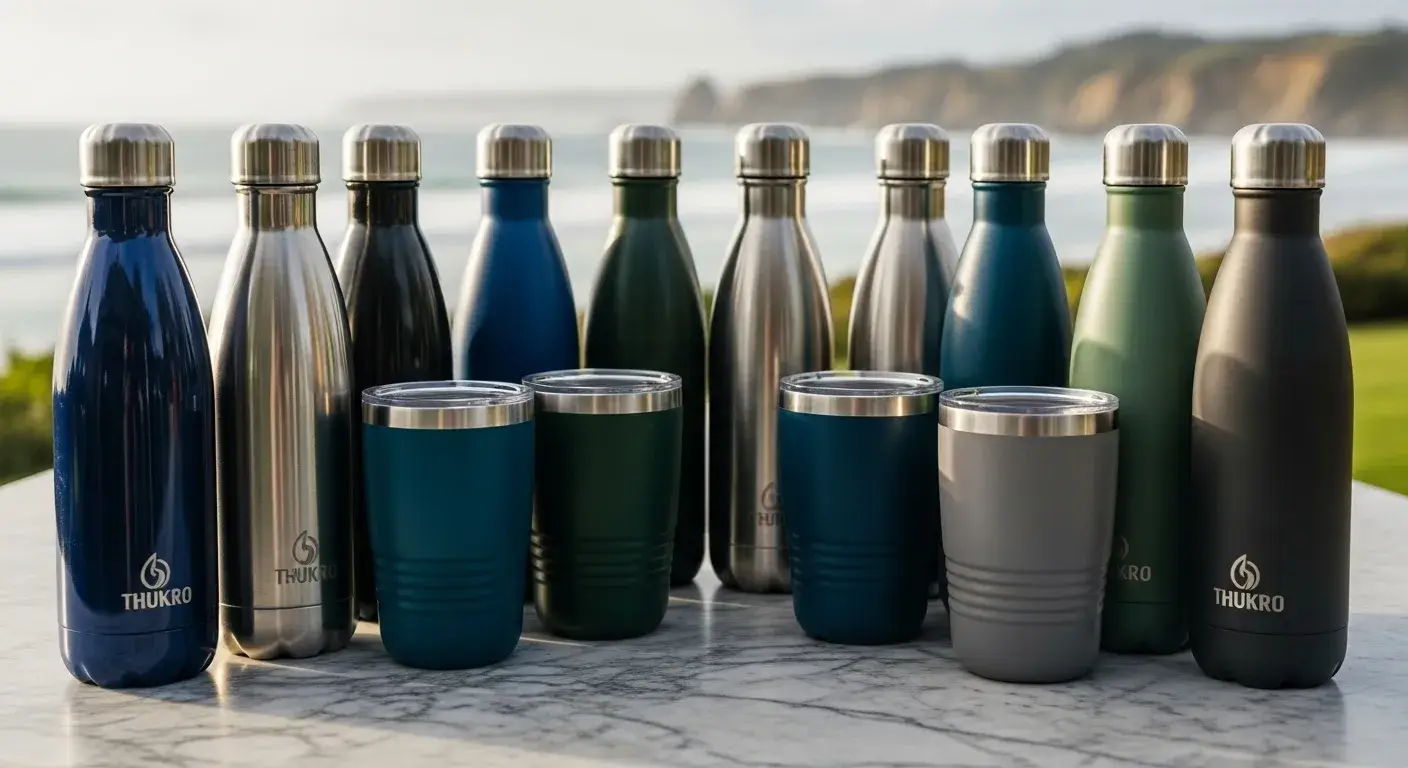
Modern 316 stainless steel water bottles and tumblers in various designs
Marine-Grade Corrosion Resistance:
The 2-3% molybdenum content creates a protective barrier that resists:
- Chloride attack from saltwater or mineral-rich water
- Pitting corrosion that can develop around seams and welds
- Crevice corrosion in threaded areas and gasket interfaces
- Stress corrosion cracking under thermal cycling
Food Safety Certifications:
316 stainless steel meets comprehensive safety standards:
- FDA 21 CFR 177.2600 for direct food contact
- LFGB Germany for European market compliance
- NSF International certification for drinking water applications
- ASTM F138 for biocompatibility requirements
Experienced manufacturers understand that these certifications are essential for entering premium markets and building consumer trust.
Daily Use Durability:
Unlike lower grades, 316 stainless steel maintains its appearance and performance through:
- Thousands of wash cycles without degradation
- Impact resistance from daily handling and drops
- Thermal shock resistance from hot and cold beverages
- Chemical resistance to cleaning agents and sanitizers
Will Stainless Steel 316 Rust? Understanding Corrosion Resistance
While 316 stainless steel offers exceptional corrosion resistance, it's important to understand its limitations for proper application. Therefore, manufacturers must consider specific use conditions when specifying materials.
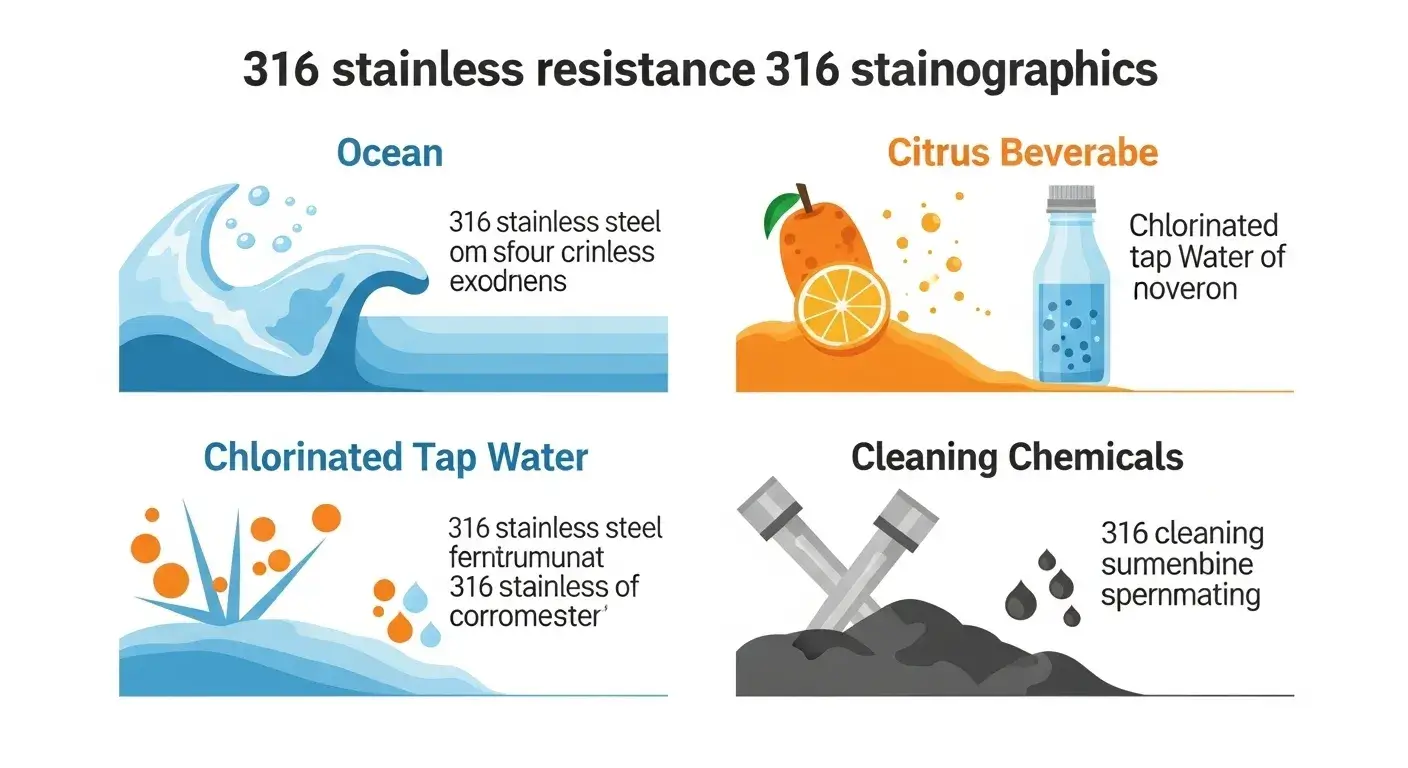
Corrosion resistance testing showing 316 stainless steel performance in various environments
Where 316 Excels:
- Saltwater environments up to 60°C temperature
- Acidic beverages including citrus juices and sports drinks
- Chlorinated water from municipal treatment systems
- Daily washing with standard detergents and sanitizers
Potential Limitations:
Despite its premium status, 316 stainless steel can experience corrosion under extreme conditions:
- Warm seawater above 60°C may cause pitting over extended exposure
- Highly concentrated acids like nitric acid can cause surface etching
- Stagnant chloride solutions in poorly designed crevices
- Galvanic corrosion when coupled with dissimilar metals
Maintenance for Maximum Lifespan:
Proper care ensures optimal performance:
- Regular cleaning with mild detergents prevents buildup
- Thorough drying eliminates stagnant moisture
- Avoid abrasive cleaners that can scratch the protective oxide layer
- Periodic passivation restores the protective surface film
According to Materials Performance Magazine, properly maintained 316 stainless steel can last decades in normal drinkware applications without significant corrosion.
What are the Disadvantages of 316 Stainless Steel?
Understanding 316 stainless steel's limitations helps manufacturers make realistic cost-benefit analyses. Moreover, awareness of these challenges enables better product design and customer education.
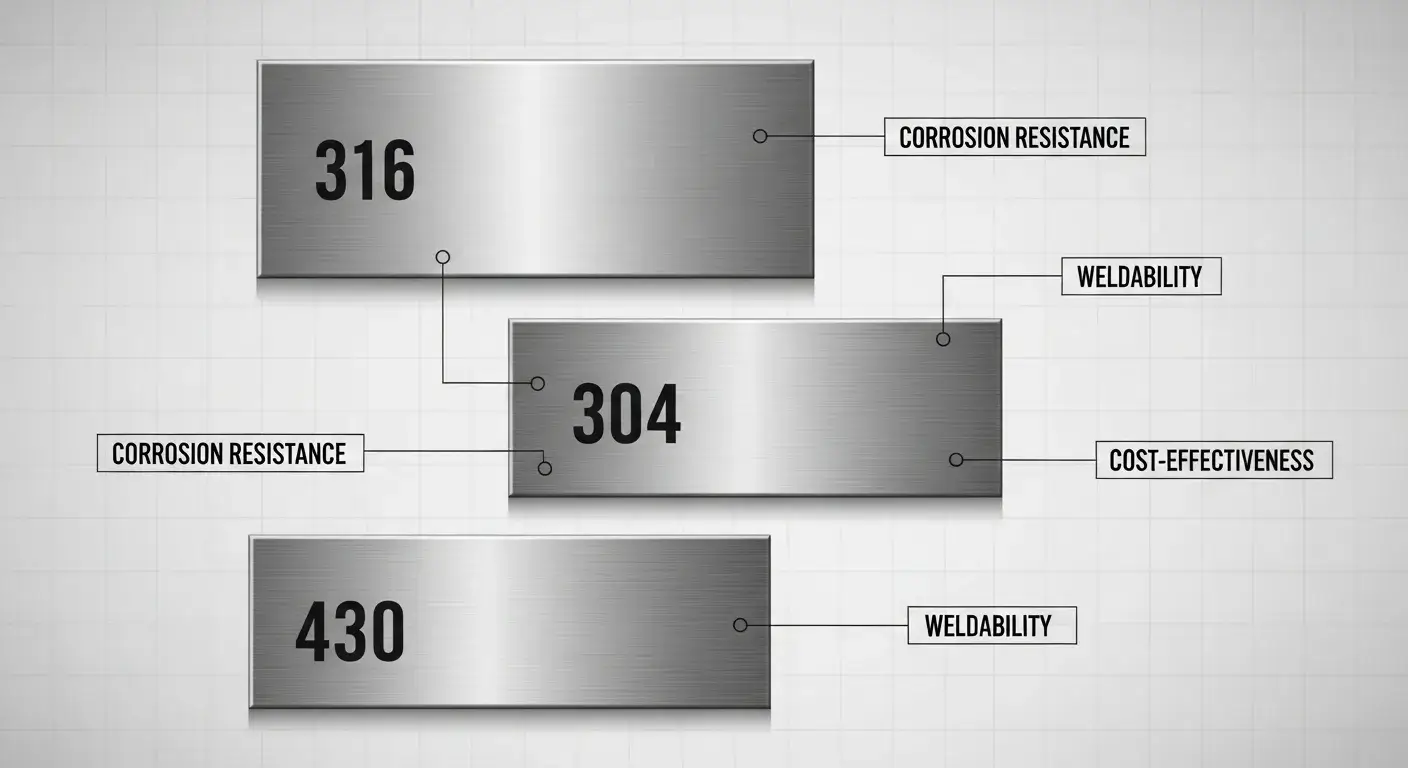
Cost Considerations:
- Material cost is approximately 40% higher than 304 grade
- Machining expenses increase due to work-hardening properties
- Welding complexity requires specialized techniques for optimal results
- Inventory management costs rise with premium material handling
Manufacturing Challenges:
316 stainless steel presents certain production difficulties:
Machinability: Only 40% as machinable as carbon steel due to work-hardening characteristics. Consequently, manufacturers must use specialized tooling and cutting parameters.
Cold Working: The material work-hardens rapidly during forming operations, therefore requiring careful process control and potential intermediate annealing steps.
Welding Considerations: Standard 316 grade can develop carbide precipitation during welding, although 316L variant addresses this issue effectively.
Market Positioning Challenges:
- Consumer education required to justify premium pricing
- Competition from lower-cost alternatives in price-sensitive markets
- Supply chain complexity with specialized suppliers and longer lead times
However, professional manufacturers successfully overcome these challenges through proper process optimization and market positioning strategies.
Is it Safe to Cook on 316 Stainless Steel? Food Safety Explained
316 stainless steel's food safety credentials make it an excellent choice for drinkware applications. Furthermore, its compliance with international standards provides manufacturers with confidence in global market access.
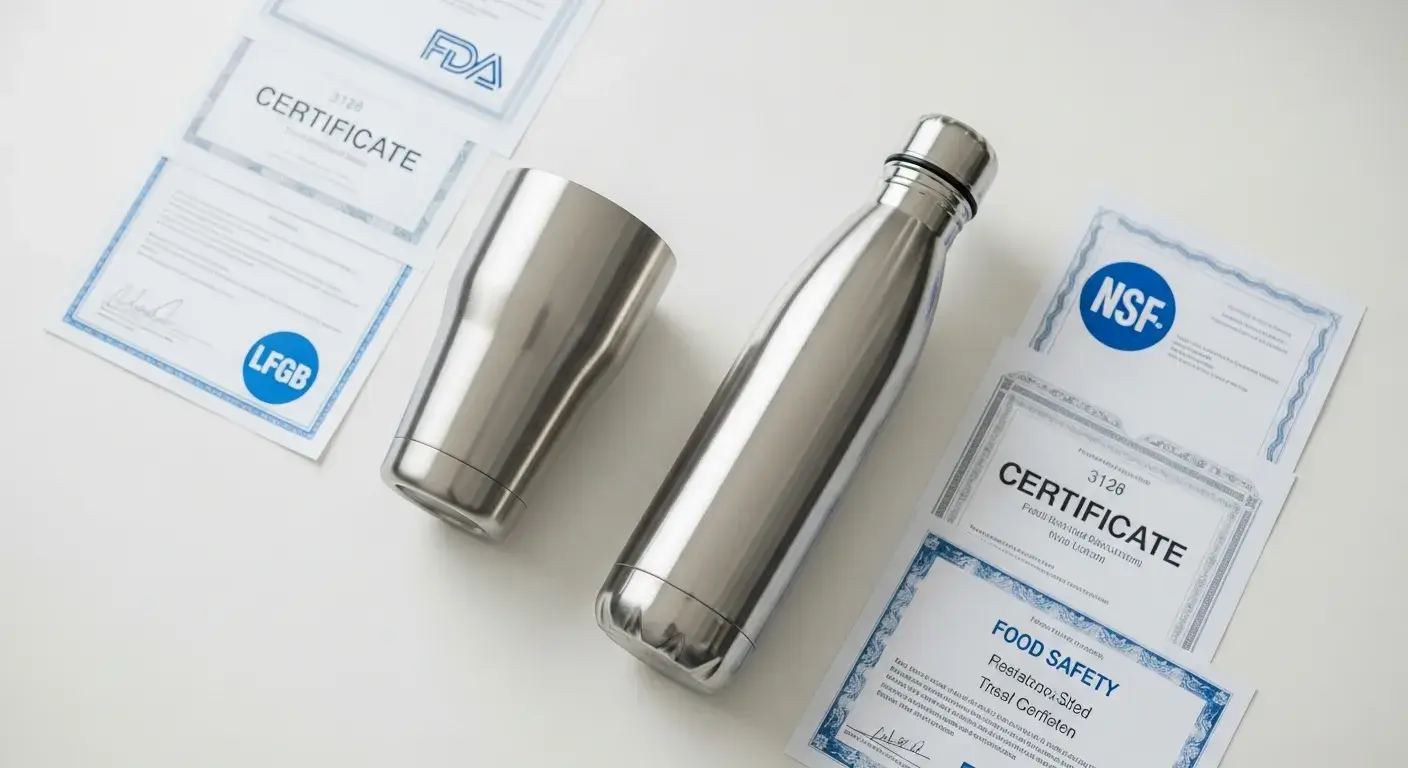
FDA and LFGB certification logos with 316 stainless steel cookware and drinkware
FDA Compliance for Drinkware:
The FDA recognizes 316 stainless steel under regulation 21 CFR 177.2600 as safe for direct food contact. Additionally, this approval covers:
- Hot and cold beverages across the full temperature range
- Acidic drinks including fruit juices and carbonated beverages
- Long-term contact for storage applications
- Repeated use through normal washing and sanitizing cycles
International Safety Certifications:
- LFGB (Germany): Comprehensive testing for European market access
- JIS (Japan): Japanese industrial standards for food contact materials
- ASTM F138: Biocompatibility standards for medical-grade applications
- NSF International: Drinking water system component certification
Leaching and Migration Testing:
Extensive testing demonstrates that 316 stainless steel has:
- Minimal metal ion migration into beverages under normal use
- No toxic compound formation during thermal processing
- Stable surface chemistry that doesn't react with common beverages
- Long-term stability without degradation of safety properties
According to the European Food Safety Authority, properly manufactured 316 stainless steel presents no safety concerns for food contact applications when used as intended.
Comparison with Other Materials:
Unlike some alternatives, 316 stainless steel offers:
- No BPA concerns associated with plastic containers
- Better thermal stability than aluminum alloys
- Superior corrosion resistance compared to lower stainless grades
- Recyclability supporting environmental sustainability goals
What is the Life Expectancy of 316 Stainless Steel Drinkware?
316 stainless steel drinkware offers exceptional longevity, making it an excellent value proposition for both manufacturers and consumers. Therefore, understanding its lifespan helps position products effectively in the market.

Lifecycle comparison showing 316 stainless steel durability over decades
Expected Lifespan Data:
Under normal use conditions, 316 stainless steel drinkware typically lasts:
- 20-30 years for daily-use water bottles with proper care
- 15-25 years for insulated tumblers with regular washing
- 10-20 years in harsh environments like marine applications
- Lifetime warranty potential for premium product positioning
Factors Affecting Longevity:
Several variables influence the actual lifespan:
Usage Intensity: Daily use with multiple wash cycles versus occasional use significantly impacts wear patterns.
Maintenance Quality: Proper cleaning and drying extends lifespan considerably compared to neglected care routines.
Environmental Exposure: Marine environments, industrial settings, or extreme temperatures may accelerate wear.
Manufacturing Quality: Professional manufacturing processes ensure optimal material properties and joint integrity.
Value Proposition for End Customers:
The longevity of 316 stainless steel creates compelling value arguments:
- Cost per use becomes minimal over the product's lifetime
- Replacement frequency drops dramatically compared to alternatives
- Environmental impact reduces through extended product life
- Brand loyalty increases with long-lasting, reliable products
Real-World Performance Examples:
Marine industry data shows 316 stainless steel components functioning effectively after:
- 40+ years in shipbuilding applications
- 25+ years in offshore oil platforms
- 30+ years in chemical processing plants
- 20+ years in food processing equipment
This proven track record translates directly to exceptional drinkware performance expectations.
How to Verify 316 Stainless Steel Quality (Crucial for B2B Buyers)
Quality verification represents a critical step for importers and distributors sourcing 316 stainless steel drinkware. Consequently, understanding proper verification methods protects against substandard materials and ensures customer satisfaction.
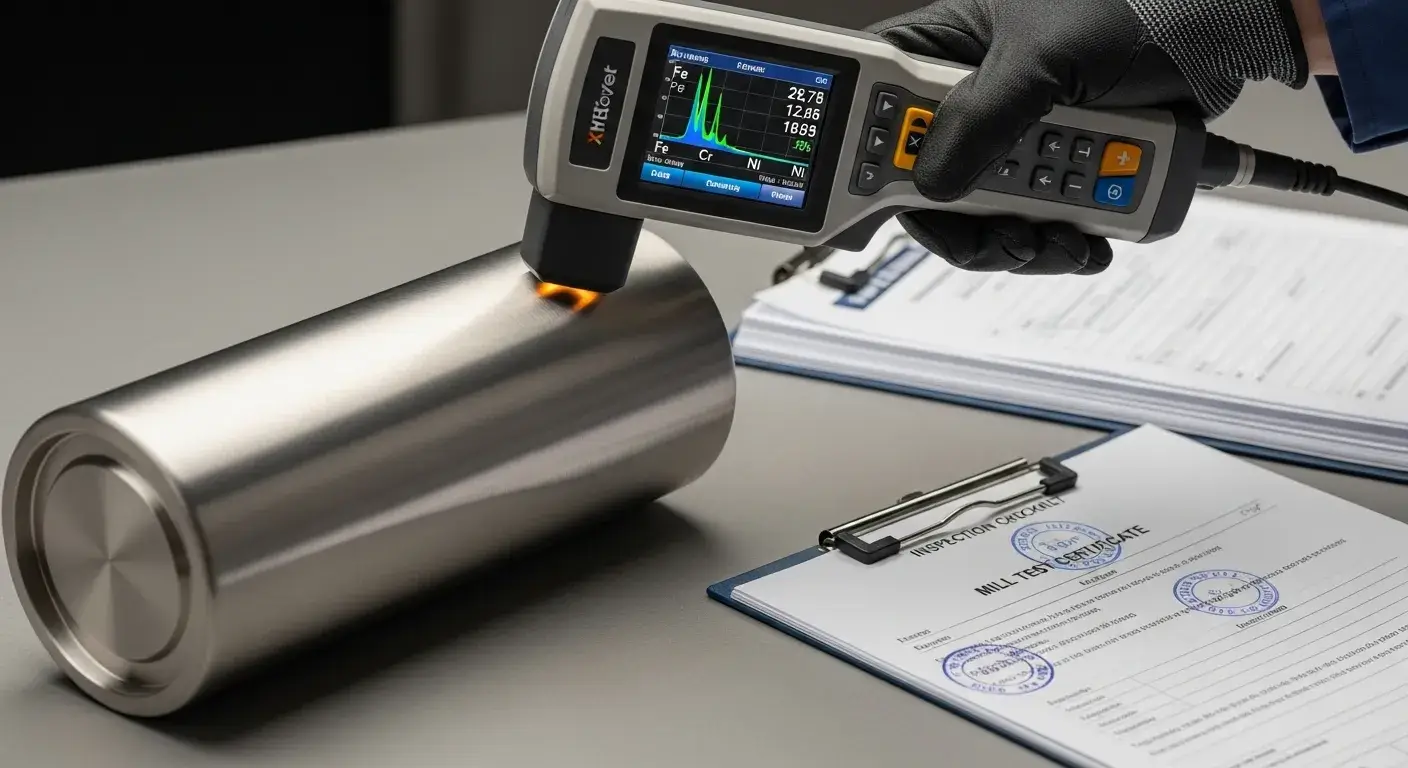
Quality testing equipment showing XRF analyzer and material certificates
Essential Documentation Requirements:
Mill Test Certificates (MTC): These documents must include:
- Chemical composition analysis showing actual percentages of chromium, nickel, and molybdenum
- Mechanical property testing results for tensile strength and yield strength
- Heat number traceability linking materials to specific production batches
- Standard compliance verification (ASTM A240, EN 1.4401, etc.)
Third-Party Certifications: Independent verification provides additional assurance:
- SGS or TUV inspection reports for material composition
- FDA compliance certificates for food contact applications
- LFGB testing results for European market requirements
- ISO 9001 manufacturing certificates from the supplier
Practical Verification Methods:
Chemical Analysis Testing:
- XRF (X-Ray Fluorescence) provides rapid, non-destructive composition analysis
- OES-ICP (Optical Emission Spectroscopy) offers high precision for critical elements
- Portable analyzers enable on-site verification during inspections
- Laboratory confirmation for disputed or critical shipments
Physical Testing Approaches:
- Magnet testing (limited reliability due to cold working effects)
- Spark testing by experienced technicians for preliminary screening
- Acid testing kits for molybdenum detection (requires safety precautions)
- Hardness testing to verify proper heat treatment
Red Flags to Avoid:
Experienced buyers watch for these warning signs:
- Suspiciously low pricing compared to market rates for 316 grade
- Reluctance to provide certificates or documentation delays
- Generic or altered certificates without proper authentication
- Inconsistent marking or grade designations on products
Established manufacturers provide comprehensive documentation and welcome third-party verification as proof of their quality commitment.
Supplier Audit Considerations:
When evaluating potential suppliers, verify:
- Raw material sourcing from reputable steel mills
- Quality control systems including incoming material inspection
- Testing equipment calibration and maintenance records
- Traceability systems linking finished products to source materials
316L vs 316: Which Grade Should You Choose for Manufacturing?
The choice between 316 and 316L stainless steel significantly impacts manufacturing processes and product performance. Moreover, understanding their differences helps optimize production efficiency and cost management.
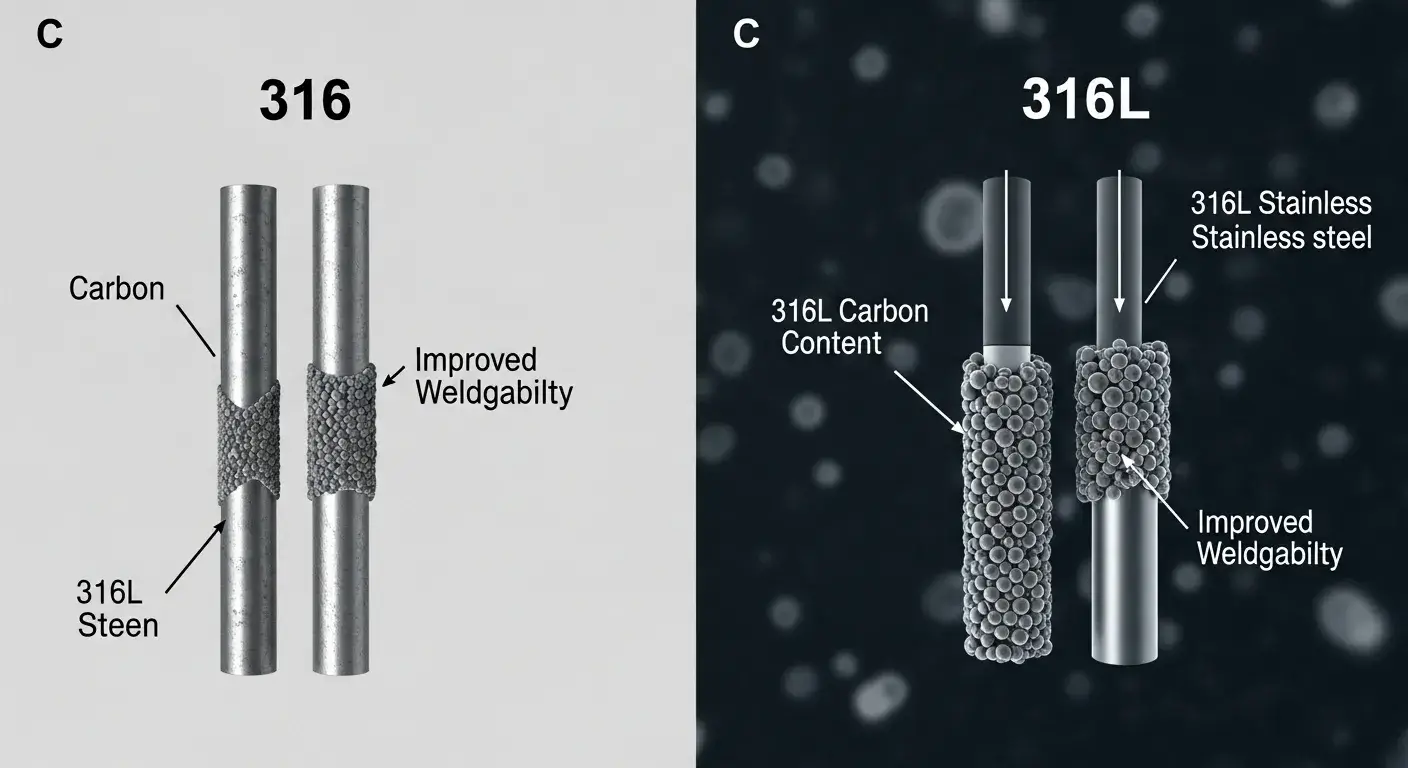
Microscopic comparison showing carbon content differences between 316 and 316L
Key Technical Differences:
| Property | 316 Standard | 316L Low Carbon |
|---|---|---|
| Carbon Content | ≤0.08% | ≤0.03% |
| Welding Performance | May require post-weld treatment | Excellent weldability |
| Sensitization Risk | Higher at 425-860°C | Minimal risk |
| Cost | Slightly lower | Premium pricing |
| Availability | Standard stock item | May require special order |
Manufacturing Considerations:
Welding Applications: 316L excels in welded assemblies because:
- Lower carbon content prevents carbide precipitation during welding
- No post-weld heat treatment required in most applications
- Better corrosion resistance in welded joint areas
- Reduced sensitization eliminates intergranular corrosion risks
Forming and Fabrication: Both grades offer similar properties for:
- Deep drawing operations for bottle and tumbler shapes
- Spinning processes for seamless construction
- Roll forming for complex geometries
- Machining operations with appropriate tooling
Cost Implications:
The price difference typically ranges from 5-15% premium for 316L, justified by:
- Reduced processing costs from eliminated post-weld treatments
- Higher yield rates due to better weldability
- Extended tool life in some machining applications
- Premium market positioning for high-end products
Application Recommendations:
Choose 316L for:
- Welded assemblies like insulated tumbler construction
- Complex geometries requiring multiple forming operations
- Premium product lines where cost is less critical
- Marine applications with extended warranty requirements
Choose 316 for:
- Simple formed parts without welding requirements
- Cost-sensitive applications where savings matter
- Standard inventory items with predictable demand
- Secondary operations like machining after forming
According to Stainless Steel World, approximately 70% of new 316 grade specifications now specify 316L due to its processing advantages.
Making the Right Choice for Your Drinkware Business
Selecting 316 stainless steel for drinkware manufacturing represents a strategic decision that impacts product positioning, customer satisfaction, and long-term business success. Furthermore, this choice requires careful consideration of market requirements, manufacturing capabilities, and cost structures.

Strategic decision matrix showing factors for choosing 316 stainless steel in drinkware manufacturing
Strategic Market Positioning:
316 stainless steel enables manufacturers to position products in premium market segments where:
- Quality commands premium pricing and customers value durability
- Brand differentiation becomes possible through superior materials
- Warranty offerings can extend longer due to material reliability
- Customer loyalty builds through consistent product performance
Manufacturing Investment Considerations:
Successful 316 stainless steel implementation requires:
- Specialized tooling optimized for work-hardening characteristics
- Quality control systems ensuring proper material verification
- Skilled workforce understanding 316 grade processing requirements
- Supply chain partnerships with reliable steel suppliers
Market Segments Where 316 Excels:
- Premium outdoor gear targeting serious adventurers and professionals
- Corporate gifting where quality reflects brand values
- Marine markets requiring salt-water corrosion resistance
- Health-conscious consumers preferring safe, durable materials
The growing awareness of environmental sustainability also favors 316 stainless steel's recyclability and longevity compared to disposable alternatives.
Return on Investment Analysis:
While 316 stainless steel requires higher initial investment, benefits include:
- Reduced warranty claims due to superior durability
- Premium pricing opportunities in quality-focused markets
- Brand reputation enhancement through consistent performance
- Customer lifetime value increase through satisfaction and loyalty
Leading manufacturers successfully leverage these advantages to build sustainable competitive positions in the premium drinkware market.
Conclusion: Partner with 316 Stainless Steel Experts for Your Success
316 stainless steel represents the gold standard for premium drinkware manufacturing, offering unmatched corrosion resistance, food safety compliance, and long-term durability. However, success with this premium material requires expert manufacturing partners who understand its unique properties and processing requirements.
At Sibottle, we specialize in 316 stainless steel drinkware with 14+ years of experience, 1000-piece MOQ, and 1000+ customizable designs. Our ISO 9001 certified facility ensures FDA and LFGB compliance for global market access.
Ready to source premium 316 stainless steel drinkware?
Get your custom quote within 12 hours – contact us now! or Learn more: sibottle.com

